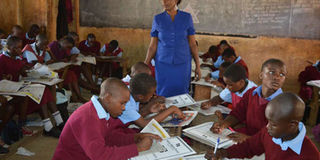School curriculum to place emphasis on talent development

Class Eight pupils of Nabongo Primary School carry on with their studies on March 14, 2017. The new education syllabus will focus on nurturing talents of learners. PHOTO | ISAAC WALE | NATION MEDIA GROUP
What you need to know:
- The Kenya School Readiness Assessment Tool will then be used to determine the readiness of the child to enter Grade 1.
- Learners in lower secondary school will undergo a rigorous career guidance programme and be exposed to the related subjects.
Pupils in lower primary schools will no longer be subjected to examinations as instead the focus will be on acquisition of skills under the new curriculum.
The Basic Education Curriculum Framework, developed by Kenya Institute of Curriculum Development, indicates that a competency-based approach will enable better understanding of subjects.
The framework, which is a guide to the review, states that the new system will put more emphasis on identifying talents and nurturing them as opposed to the current one that is heavily focused on examinations.
LEARNER'S PROGRESS
Emphasis will be on continuous assessment tests rather than end-of-cycle tests, according to the framework.
“The teacher will continuously gather information about the learner using various methods including the learner’s portfolio progress records and observation of the learner’s abilities and competence,” it adds.
The institute has also developed a progress assessment tool for the pre-primary level whose purpose will be to find out the degree of the child’s holistic development in the physical, cognitive, language, socio-emotional, creative, aesthetic, spiritual and moral aspects.
The tool will measure the child’s level of achievement in various competencies and provide feedback to teachers and parents.
TYPES OF ASSESSMENT
It uses a three-point rating scale: “Able to”, “Sometimes” and “Not able to”.
In the checklist, “Able to” is ticked when a child always demonstrates the competency in question; “Sometimes” is if the child demonstrates the competency in question at certain instances and not others and “Not able to” is if the child does not demonstrate a given competency at all.
The Kenya School Readiness Assessment Tool, which has been developed by the Education ministry, will then be used to determine the readiness of the child to enter Grade 1.
“There will be two types of assessment in upper primary. Formative assessment from Grades 4-6 will be continuous through individual learners’ portfolios,” states the framework.
REMEDIAL MEASURES
It adds that to transit to Grade 7, a national assessment will be administered at Grade 6.
“This national assessment will not be individualised but will aim at giving an overall picture on whether the learners have acquired the expected competencies for this level.
"Learners will be randomly sampled across the country and assessed using standardised tools, which will then be marked and analysed to get an overall picture of the entire population transiting to Grade 7. The results will help teachers to take appropriate action,” adds the framework.
The learner will also be the first person to receive feedback from formative assessment and parental engagement will also be required in remedial measures to be taken for learners.
“Graduates of primary school Grade 6 shall join lower secondary school at Grade 7. Lower secondary school will expose the learner to a broad based curriculum to enable them to explore their own abilities, personality and potential,” states the framework.
CAREER GUIDANCE
Learners in lower secondary school will undergo a rigorous career guidance programme and be exposed to the related subjects to enable them to make informed choices as they transit to senior school.
Senior school comprises three years of education targeted at learners in the age bracket of 15 to 17 years and lays the foundation for further education and training at the tertiary level and work.
“The specialisation entails choosing to pursue studies in one of the three pathways. He or she can choose the Arts and Sports Science, Social Sciences or Science Technical Engineering and Mathematics pathway,” states the framework.





